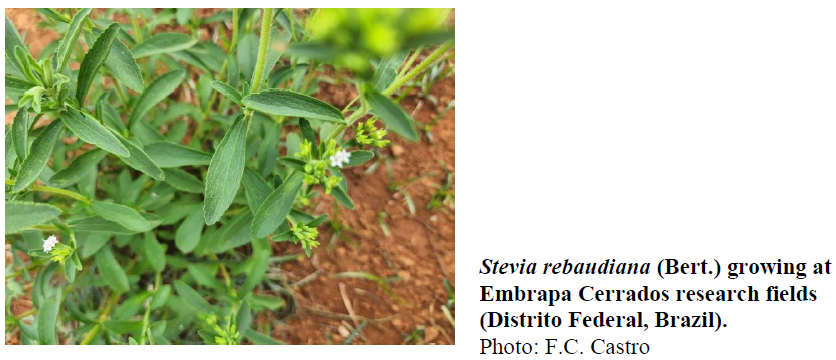Selection of stevia elite genotypes aiming at the development of cultivars adapted to the Brazilian Savanna

Abstract
In this work, the objective was to evaluate morphoagronomic traits, correlate and select elite genotypes of Stevia rebaudiana (Bert.) Hemsley with high productivity, and adapted to Brazilian Savanna conditions. A total of 230 genotypes were evaluated, from the Embrapa Cerrados Working Collection, from 2018 to 2019, with 24 evaluations, carried out in six cuts, with each cut representing a certain moment of generation of the response data of the analyzed genotypes. Four traits were analyzed: green biomass production (g), plant height (cm), tillering number and juvenile period of each individual. The means of the characteristics of each genotype were correlated according to Pearson's correlation coefficient. The Mulamba and Mock index was applied, with a selection intensity of 10%, to choose the superior genotypes. There are high positive correlations between juvenile period, height and green biomass production. The selected population were 23 superior genotypes, based on the application of rank sum resulting in high selection gains for the traits of interest. Finally, the selection of elite stevia genotypes with high production of green biomass, greater insensitivity to length of the daily light period, as well as taller plants, are essential for the continuity of the stevia breeding program on the Brazilian Savanna.
Keywords
Stevia rebaudiana (Bert.) Hemsley, Breeding programs, Correlation, Yield increases, Tillering, Vegetative stage, Plant height
References
- Btru, N.T., A. Gebere, H. Melkamu, and L. Belistie. 2017. Influence of plant population density on growth and yield of stevia (Stevia rebaudiana Bertoni L.). Int. J. Adv. Biol. Biomed. Res. 5(1), 19-26.
- Carvalho, F.I.F., C. Lorencetti, and G. Benin. 2004. Estimativas e implicações da correlação no melhoramento vegetal. Universidade Federal de Pelotas, Pelotas.
- Cruz, C.D. 2013. GENES: A software package for analysis in experimental statistics and quantitative genetics. Acta Sci. Agron. 35(3), 271-276. Doi: https://doi.org/10.4025/actasciagron.v35i3.21251
- Cruz, C.D., P.C.S. Carneiro, and A.J. Regazzi. 2014. Modelos biométricos aplicados ao melhoramento genético. 3rd ed. Editora Universidade Federal de Viçosa, Viçosa, Brazil.
- De, S., S. Mondal, and S. Banerjee. 2013. Stevioside: technology, applications and health. John Wiley & Sons, Chicheste, UK. Doi: https://doi.org/10.1002/9781118350720
- Francisco, F., G.P. Pereira, M. Machado, L.A. Kanis, and C. Deschamps. 2018. Characterization of Stevia rebaudiana Bertoni accessions cultived in southern Brazil. J. Agric. Sci. 10(3), 353-363. Doi: https://doi.org/10.5539/jas.v10n3p353
- Lima Filho, O.F., A.C.C. Valois, and Z.M. Lucas (eds.). 2004. Estévia. Sistema de Produção 5. Embrapa Agropecuária Oeste; Steviafarma Industrial S/A, Dourados, Brazil.
- Mengesha, B., W. Geja, and Z. Damtew. 2014. Stevia production guideline. Ethiopian Institute of Agricultural Research Center, Addis Ababa.
- Mulamba, N.N. and J.J. Mock. 1978. Improvement of yield potential of the ETO blanco maize (Zea mays L.) population by breeding for plant traits [Mexico]. Egypt. J. Genet. Cytol. 7(1), 40-51.
- Pelá, M. and D. Castilho (Orgs.). 2010. Cerrados: perspectivas e olhares. Ed. Vieira, Goiânia, Brazil.
- Santos, H.G., P.K.T. Jacomine, L.H.C. Anjos, V.A. Oliveira, J.F. Lumbreras, M.R. Coelho, J.A. Almeida, J.C. Araújo Filho, J.B. Oliveira, and T.J.F. Cunha. 2018. Sistema brasileiro de classificação de solos. 5th ed. rev. e ampl. Embrapa, Brasília, DF.
- Sayd, R.M., R.F. Amabile, F.G. Faleiro, A.P.L. Montalvão, and M.C. Coelho. 2019. Comparison of selection indices in the selection of malting barley genotypes irrigated. Acta Sci. Agric. 3(9), 80-89. Doi: https://doi.org/10.31080/ASAG.2019.03.0611
- Serfaty, M., M. Ibdah, R. Fischer, D. Chaimovitsh, Y. Saranga, and N. Dudai. 2013. Dynamics of yield components and stevioside production in Stevia rebaudiana grown under different planting times, plant stands and harvest regime. Ind. Crops Prod. 50, 731-736. Doi: https://doi.org/10.1016/j.indcrop.2013.08.063
- Taleie, N., Y. Hamidoghli, B. Rabiei, and S. Hamidoghli. 2012. Effects of plant density and transplanting date on herbage, stevioside, phenol and flavonoid yield of Stevia rebaudiana Bertoni. Int. J. Agric. Crop Sci. 6(4), 298-302.
- Tavarini, S., B. Passera, and L.G. Angelini. 2018. Crop and steviol glycoside improvement in stevia by breeding. pp. 1-31. In: Wölwer-Rieck, U. (ed.). Steviol glycosides: Cultivation, processing, analysis and applications in food. Royal Society of Chemistry, London. Doi: https://doi.org/10.1039/9781788010559-00001
- Yadav, A.K., S. Singh, D. Dhyani, and P.S. Ahuja. 2011. A review on the improvement of stevia [Stevia rebaudiana (Bertoni)]. Can. J. Plant Sci. 91(1), 1-27. Doi: https://doi.org/10.4141/cjps10086
